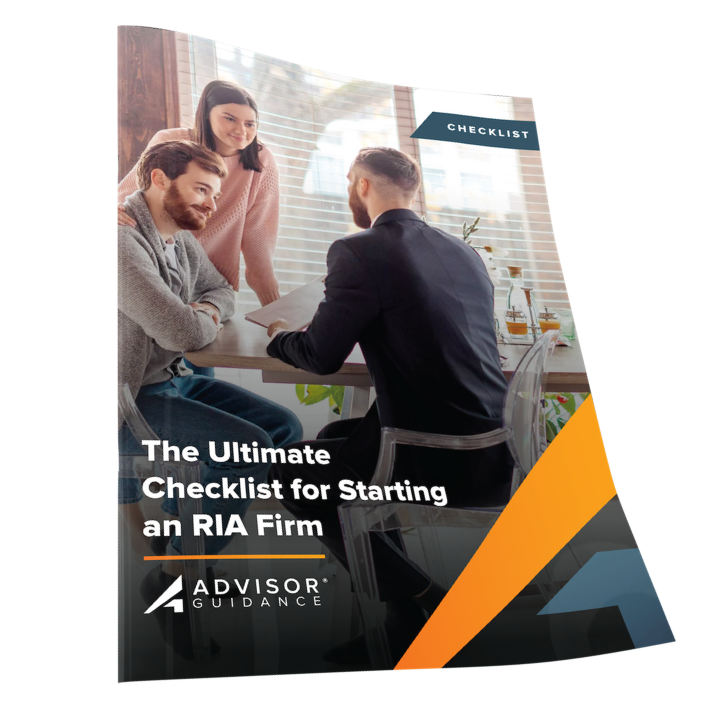The Easiest Way to
Register Your RIA Firm 
Starting a Registered Investment Advisor (RIA) firm offers a variety of benefits to those who want to embrace their independence. However, many investment advisors quickly find themselves overwhelmed by the long list of requirements they need to address to create an RIA firm.
We know just how intimidating it can be to start a new company. We also know that most investment advisors would rather spend their time building their new firm than getting bogged down in a sea of rules and regulations.
Since 2006, hundreds of small to midsize RIAs have relied on us to manage every step of the registration process for them. Through our turnkey RIA registration process, we draft and file all your required documents, communicate directly with the appropriate regulators on your behalf, and provide everything you need from a compliance perspective to get your firm up and running with confidence.
So, if getting your firm registered the right way, in the shortest period of time matters, we should talk.
The Top 10 RIA Registration Questions
What exams are required to become an IAR?
To establish an investment advisory firm, all individuals involved with providing investment advice to your clients must pass a Uniform Advisor Exam or qualify for an exemption. The exam options include the Series 65 (“Uniform Investment Advisor Exam”) and the Series 66 (Uniform Combined State Law Exam).
Advisor applicants who have an active Series 7 exam (no longer than 2 years unaffiliated with a broker-dealer), may opt for the Series 66 exam instead of the Series 65 exam. The Series 66 is narrower in scope and therefore less difficult.
Are there exemptions to the Series 65 or Series 66 exam?
Yes. Certain professionals designations, held in good standing and reported to FINRA, such as Certified Financial Planner (“CFP”), Chartered Financial Analyst (“CFA”), Personal Financial Specialist (“PFS”), Chartered Financial Consultant (“ChFC”) or Chartered Investment Counselor (“CIC”) will typically enable an advisor to request an exemption from the exam requirements in most states.
The applicant is still required to apply for registration as an IAR by filing a Form U4 and paying the associated registration fees to the applicable state securities regulator.
Do I register my RIA with the State or the SEC?
Under the current regulations, investment advisors with less than $100 million in assets under management within four months of their firm approval must register with the state regulators. You register your firm in the state where you have your principal place of business. Once a state Registered Investment Advisor‘s assets under management exceed $110 million, they must register with the SEC. [Note: You can voluntarily register with the SEC when assets exceed $100 million]
There are some exemptions that enable advisors with less than $100 million in assets under management to register with the SEC.
Can I start the Registration process without a legal entity?
Yes, you can start preparing for the RIA registration process without a legal entity in place. Firms may be operated as a sole proprietorship, meaning there is no separate legal entity from the individual starting the firm. However, most RIA firms are organized legal entities (such as an LLC or corporation), which helps limit personal liability
How long does the registration process take?
The registration process, including entitlement and Form ADV filing, generally will take between six and eight weeks, depending on the complexity of the services offered by your firm and the backlog of pending applications at the various regulatory agencies. Please note that some states, like Florida, Nevada, New Jersey, Utah and Washington may take longer than average.
At both the SEC and state level, the regulators have between six and eight weeks from the date your application is submitted to respond to us with questions about the pending application. Our goal is to respond as quickly as possible to help keep the process moving forward.
In which states do I need to file?
State registered investment advisor firms must be registered in their home state (where the principal office is located). “Principal office” means the place of business from which the registered investment advisor representative (IAR) operates the majority of the time. Many IARs spend the majority of their time working from a home office and also have a subscription to a shared office space where they meet clients or receive firm mail. Both offices must be reported on Form ADV. The home state is not necessarily the state in which the IAR resides. For example, many IARs live in New Jersey or Connecticut and commute to their office in New York. In this example, the home state is New York, where the principal office is located.
As the investment advisory business grows and clients from other states are added to the firm, the Chief Compliance Officer is responsible for monitoring the number of clients in those other states. In general, investment advisory firms may advise up to five clients in each of the other states without having to apply for registration or pay any fees. Before taking on the sixth client, the firm must apply for registration and be approved.
One exception to the general rule, however, applies when a firm has a “place of business” in another state. For example, the firm may hire a new IAR who resides in a different state and plans to work from an office in that other state. Before the IAR may start advising clients, the firm, its Chief Compliance Officer, and the new IAR must be registered in that state.
Another exception to the general rule applies to firms advising Texas and Louisiana resident clients. Those states both require non-resident investment advisor firms to make a “notice filing” before advising even the first client there. The Chief Compliance Officer and any IARs advising residents in those states must also be approved for registration. And before taking on the sixth Texas or Louisiana client, the firm must be apply and be approved for a full registration.
For SEC registered investment advisors, the firm must be “notice filed” in its home state (same definition as in the first paragraph above). The firm must also be notice filed in any state where it advises six or more clients, except for Texas, Louisiana, Nebraska, and New Hampshire, where the firm must be notice filed prior to advising even the first client. IARs of SEC registered investment advisors are only required to be registered in their home state, as well as Texas if they are advising any clients there, and any other state where they will be working from a “place of business.”
What forms do I need to file?
Form ADV is the form investment advisors must complete in order to become registered with either the SEC or the state regulators. Form ADV explains to the regulators how you intend to run your business.
Form ADV Part 1 is filed electronically through the IARD system. Firms registering with the SEC must complete Part 1A and firms registering with the state(s) must complete Part 1A and Part 1B.
The Form ADV Part 2A (Brochure) and 2B (Brochure Supplement) are your disclosure documents that you will provide to prospective clients explaining how your firm operates and who your investment advisor representatives are. You are required to offer or deliver these documents to your existing clients on an annual basis. These documents are also required to be updated annually and filed through the FINRA IARD system within 90 days of the end of your fiscal year.
Does my RIA firm need a Chief Compliance Officer?
Yes. SEC Rule 206(4)-7 and each state’s uniform securities act requires all RIA firms to appoint a CCO to oversee the internal compliance program.
Do I have to review my compliance policies & procedures?
Yes. Investment Advisors are required to test and review their policies and procedures on an annual basis in an effort to confirm they are adequately designed and effectively implemented for the size and scope of the firm.
What is the easiest way to register an RIA firm?
The easiest way to register an RIA firm is to have Advisor Guidance do the work for you. Our turnkey registration process has helped hundreds of investment advisors achieve approval with the SEC and state securities regulators since 2006.
Our Turnkey Registration Services
Start Your RIA Firm with Confidence.
Whether you’re required to register with the SEC or state, our comprehensive, turnkey registration process helps you remove the guesswork and stress associated with starting your RIA firm.
Onboarding & Discovery
During the onboarding and discovery phase, your dedicated registration and compliance lead will take the time to gain a comprehensive understanding of your RIA firm’s business model and walk you through the FINRA Entitlement process.
Key Actions & Outcomes
- Initial business consultation and discovery call
- Preparation of Entitlement forms for you to gain access to the IARD/CRD systems
- Assistance with the funding requirements for your Flex Funding Account in FINRA’s E-Bill system
- Confirmation of applicable federal/state filing requirements
- Collect all applicable legal entity documents
Drafting & Filing Registration
After you’ve completed your onboarding and discovery call, our registration and compliance team will draft and file the proper registration documents on your firm’s behalf.
Key Actions & Outcomes
- Confirmation of intended business model of your RIA firm
- Draft, review, and file Form ADV Part 1
- Draft, review, and file Form ADV Part 2A and 2B plain English Brochure and Brochure Supplement
- If required, draft, review, and file Form ADV Part 3 Customer Relationship Summary
- If necessary, draft, review, and file Form ADV Part 2A Appendix Wrap Fee Brochure
- Draft, review, and file Form U-4 (Uniform Application for Securities Industry Registration or Transfer) for each Investment Advisor Representative
- On your behalf, liaise directly with SEC and state securities regulatory agencies
- If required, participate in discussions with your counterparts, including attorneys, accountants, or insurance carriers, to ensure consistency and understanding
Customizing Compliance Program
Once we’ve filed your registration, your dedicated registration and compliance lead will draft a customized compliance program for your firm. Out team will have your compliance program ready to go before you get approved so you can start working with clients the day your firm is approved.
Key Actions & Outcomes
- Draft and review all applicable Client Investment Advisory Agreements
- If requested, provide Investment Policy Statement/Investor Questionnaire
- If required, provide Solicitor/Promoter Agreement and Disclosure Documents
- Prepare written Compliance Program documents, tailored to firm’s business model, including:
- Written Supervisory Procedures
- Code of Ethics
- Privacy Policy
- If applicable, Massachusetts Identity Theft Program
- Cybersecurity Policy
- Proxy Voting Policy If applicable, ERISA DOL PTE 2020-02 documents
- Draft Disaster Recovery and Business Continuity Plan
Firm Approval & Launch
Once your firm is approved, you will have all the necessary compliance documents in place, including the final version of your Client Investment Advisory Agreement, so you can start onboarding clients to your firm.
Key Actions & Outcomes
- Finalize all Compliance Program documents and Client Investment Advisory Agreements
- We will provide you with a list of ongoing compliance requirements for your new RIA firm
- Further discussions and assistance as necessary as you begin to grow your new RIA firm
- You can elect to use Advisor Guidance for ongoing compliance support.
Check Out Your State's
Registration Requirements
An Introduction to the
RIA Registration Process
Starting an RIA Firm?
If you’re thinking about starting an RIA firm we’d encourage you to check out our Ultimate Checklist for Starting an RIA to help you set your firm up for success.

